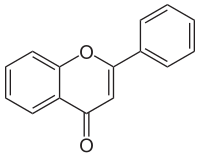
Photo from wikipedia
Abstract The antiradical capacity and mechanisms of two representative coumestan-type compounds, namely isosojagol (Iso) and phaseoul (Pha), were examined using quantum chemistry calculations and computational kinetics methods. From a thermodynamic… Click to show full abstract
Abstract The antiradical capacity and mechanisms of two representative coumestan-type compounds, namely isosojagol (Iso) and phaseoul (Pha), were examined using quantum chemistry calculations and computational kinetics methods. From a thermodynamic point of view, the 18CH groups of the prenyl substituent have been found to be the most suitable sites for radical attacks via the formal hydrogen transfer (FHT) mechanism. However, the kinetic study revealed that the reaction at these CH groups is slow and does not contribute to the overall reactivity of these compounds, which the phenolic groups mainly define. The kinetic study also revealed that the studied compounds are good free radical scavengers with overall rate coefficients as high as recognized antioxidants such as carnosic acid, artepillin C, thymol, and rosefuran.
Journal Title: Free Radical Research
Year Published: 2022
Link to full text (if available)
Share on Social Media: Sign Up to like & get
recommendations!